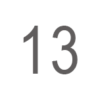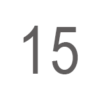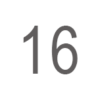Alfred Pope: An Evolution of Ingenuity
Claude Monet (French, 1840–1926)
11. Route de Monte-Carlo
12. Champ d’avoine et coquelicots
13. Étretat: Falaise d’amont, gros temp
14. Honfleur, bateaux de pêche
15. Pointes de rochers à Belle-Île
16. Bateaux échoués à Fécamp
17. Meules, effet de neige
next
Route de Monte-Carlo (The Road to Monte Carlo), 1883
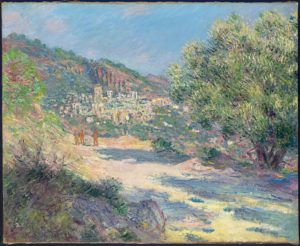
Oil on canvas, 25 ½ × 31 7/8 in. (65 × 81 cm). Private collection.
After acquiring this landscape from Monet in 1886, Galerie Durand-Ruel, Paris, sold this work to Alfred on May 16, 1893. Just two years later, Alfred sold the painting back to Durand-Ruel Gallery, New York, on April 23, 1895. Durand-Ruel Gallery subsequently sold the work to Marlborough Gallery, one of the leading fine art galleries in the United Kingdom at the time. The painting has remained in private hands since.xt
next
Champ d’avoine et coquelicots (Oat and Poppy Field), 1890
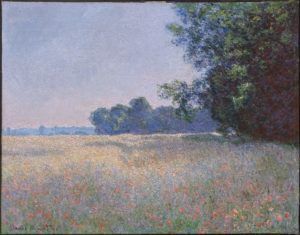
Oil on canvas, 28 ¾ × 36 ¼ in. (73 × 92 cm). William I. Koch Collection, United States.
Champ d’avoine et coquelicots is one of the many masterpieces that Theodate sold in the early 1940s. Galerie Durand-Ruel, Paris acquired this work from Monet in May of 1890. Just six months later, Alfred purchased the work from Durand-Ruel Gallery, New York on November 1, 1890. Champ d’avoine et coquelicots remained in the collection until c. 1945 when Mr. and Mrs. Ogden Phipps purchased the buoyant landscape. Phipps, a philanthropist and art collector known for his passion for horse racing, sold the painting to a private collection. By 1985, the work was at Aquavella Galleries in New York. Businessman and collector William Koch then acquired the work, and it has been in his personal collection since. We are immensely grateful for his generosity in lending this magnificent work.
next
next
Étretat: Falaise d’amont, gros temp (Étretat: Upper Cliff, Stormy Weather), c. 1884–86
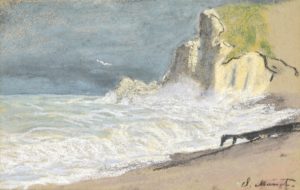
Pastel on gray paper laid down on another sheet, 9 7/8 × 14 7/8 in. (21.5 × 37.8 cm). Tom and Nan Riley, United States.
nex
next
Honfleur, bateaux de pêche (Honfleur, Fishing Boats), c. 1864–66

Pastel, 7 7/8 × 13 in. (20 × 33 cm). Private collection, France.
The Pope collection once had two Monet pastels, both depicting seascapes. While published provenances list Theodate as the owner/buyer of these works, Hill-Stead has evidence, in the form of a 1909 household inventory, which suggests that Alfred Pope acquired both pastels. This would make more sense since there is scant record of Theodate ever collecting on her own. Étretat and Honfleur were in the collection until around 1945, when, like many other masterpieces, Theodate sold them. They were both acquired by Wildenstein and Co., New York, but their paths never crossed again.
Étretat made its way around the United States. Over the years, the pastel was in private collections in Saint Louis, Missouri; Lexington, Kentucky; and Los Angeles, California. The Los Angeles-based collector sold it at a Sotheby’s auction in 1999, where the current owners acquired it. Tom and Nan Riley of Cedar Rapids, Iowa, generously lent us their invaluable piece to reunite it, for a brief time, with the rest of the Pope collection.
Honfleur also stayed in the United States for some time. Wildenstein and Co. sold the pastel to New York-based collector William M. Greve in 1959. Greve owned the painting until his passing in 1976, after which Christie’s, New York, held a sale of his estate. A private collector based in Los Angeles acquired the painting from the Christie’s sale. It subsequently moved to a private collection in France. Scholars know little about this pastel, and unfortunately, there are no color images of the work. The image seen here is the same one Wildenstein used for their sale in 1959. We were unable to reach the current owners to request the drawing on loan and ask for a color image of the seascape.
next
next
Pointes de rochers à Belle-Île (Rock Points at Belle-Ile), 1886
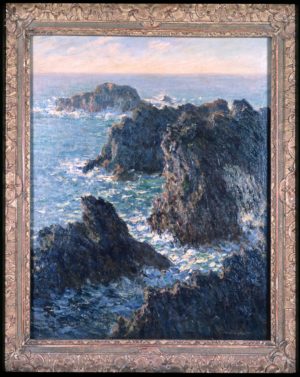
Oil on canvas, 31 7/8 × 25 ½ in. (81 × 65 cm). Private collection.
Along with Vue du cap d’Antibes, which is still in the collection, this is one of the first two works by Monet that Alfred acquired from the Parisian gallery Boussod, Valadon et Cie in 1889. And of all the paintings that left the Pope collection, Pointes de rochers à Belle-Île traveled the furthest away from Hill-Stead, all the way to Japan! This masterpiece is one of three works that Theodate sold through Knoedler in July of 1944 (the other two being Cassatt’s Mother About to Wash Her Sleepy Child, 1880, and Cassatt’s Antoinette Holding Her Child by Both Hands, c. 1899). This Monet was purchased in May of 1945 by Helen Clay Frick, the third child of the coke and steel magnate Henry Clay Frick. The masterpiece did not formally enter the Frick collection, since Helen gifted it to her lawyer and friend, William S. Moorhead of Washington, D.C. After Moorhead’s passing in 1976, the work went up for auction at Sotheby’s as part of the sale of his estate. From there, it made it to a company in Japan and is currently in a private collection.
next
Bateaux échoués à Fécamp (Boats Lying at Low Tide at Fécamp), 1881
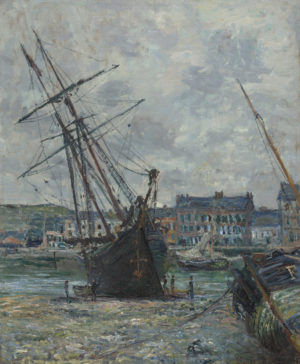
Oil on canvas, 31 ½ × 26 in. (80 × 66 cm). Private collection, United States.
Alfred acquired Bateaux échoués à Fécamp on December 14, 1892, from Galerie Durand-Ruel, Paris. He sold it back to Durand-Ruel Gallery, New York less than three months later on March 3, 1893. After that, the painting remained primarily in the homes of New York-based collectors and dealers, such as Charles Porter, Edwin C. Vogel, Sam Salz and Charles Goldman. On November 5, 1981, Goldman sold the painting at a Sotheby’s New York auction, where its current owner acquired it. We are deeply grateful to the current owner who generously lent us this masterpiece. Although Bateaux échoués à Fécamp has been in private hands throughout most of its history, the exceptional work has been promised to the Art Institute of Chicago.
next
Meules, effet de neige (Grainstacks, Snow Effect), 1891
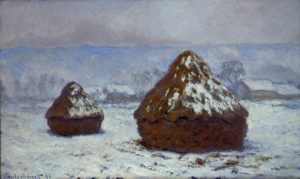
Oil on canvas, 23 ½ × 39 3/8 in. (60 × 100 cm). Shelburne Museum, Shelburne, Vermont.
Meules, effet de neige is one of the three Monet Grainstacks that Alfred acquired during his lifetime; the other two remain at Hill-Stead. He acquired Meules, effet de neige after already owning Meules, grand soleil and Les meules, effet de gelée blanche. Alfred acquired the work from Durand-Ruel Gallery, New York on January 31, 1892. It had previously been in the collection of Potter Palmer, the American businessman responsible for much of the development of State Street in Chicago. Alfred sold the painting back to Durand-Ruel Gallery on January 12, 1895. On that same day, Henri Osborne Havemeyer acquired the work. Havemeyer, a wealthy sugar magnate, donated his art collection to the Metropolitan Museum of Art in New York City, making it the largest single donation to the museum. However, he did not donate Meules, effet de neige to the museum; rather he willed it to his daughter, Electra Havemeyer Webb. She eventually donated the painting to the Shelburne Museum in Vermont, which she founded, and where it is still on view today.


